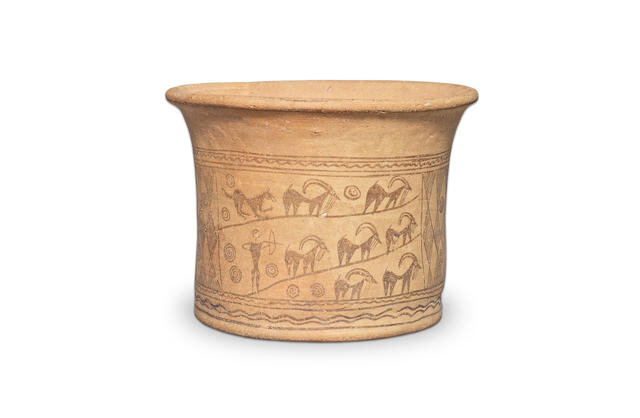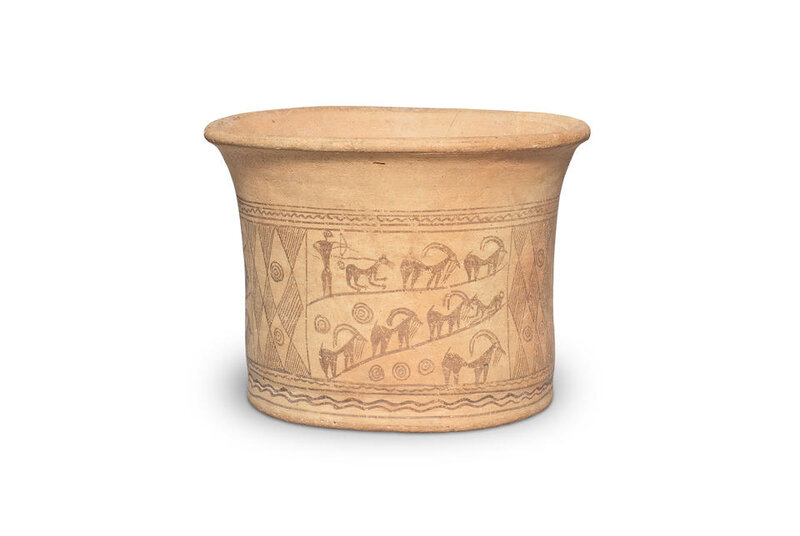Early Picture of a Dog on a Lead From the collection of Desmond Morris offered at Bonhams
Lot 2. A large Persian pottery bowl, Circa late 3rd-late 2nd Millennium B.C.; 18cm high, 23.5cm diam. Estimate £ 20,000 - 30,000 (€ 22,000 - 34,000). © Bonhams 2001-2019
One of the first known depictions of a dog on a lead is being offered at Bonhams' Antiquities Sale at New Bond Street on Wednesday 3 July. It is painted on one of three panels of a large Persian pottery jar dated circa late 3rd to late 2nd century BC, and shows a hunter with a bow and arrow holding a curly-tailed dog which, in turn, is herding goats on a mountainside. The estimate of the jar is £20,000 - 30,000.
The jar is part of the collection of Dr Desmond Morris, the celebrated broadcaster, author of The Naked Ape, and Surrealist painter. As Dr Morris told Bonhams Magazine, "The dog is shown with a lead, collar and a curly tail and he is in competition with the shaggy-coated wolf which is bristling on the other side of the vase with a characteristically horizontal tail. It gives us an insight into how these people went hunting – with a herding dog and a hunting dog."
Desmond Morris fell in love with antiquities when he walked into the Cyprus Museum in Nicosia. It prompted him to start a collection that comprised some 3,000 pieces. A selection of these Cypriot works – together with Roman, Persian, and Canaanite objects - will be offered in the sale.
As Dr Morris told Bonhams Magazine, "I saw these amazing pieces of pottery, extraordinary shapes that were so creative and imaginative, that I fell in love with them instantaneously. It was the inventiveness of the way in which they would put little figures all the way around the rim of a bowl, which were all doing things such as making bread. It was like a strip cartoon of ancient life."
Francesca Hickin, Bonhams' Head of Antiquities Department, said, "It is an honour to offer the collection of Desmond Morris. Desmond's book on Cypriot Art is the definitive volume on the subject and this is a collection that has been assembled with knowledge and with love."
Lot 2. A large Persian pottery bowl, Circa late 3rd-late 2nd Millennium B.C.; 18cm high, 23.5cm diam. Estimate £ 20,000 - 30,000 (€ 22,000 - 34,000). © Bonhams 2001-2019
Of deep cylindrical form flaring towards the rim, decorated in brown with three figurative panels separated by a chequered diamond pattern with dot and circle motifs, the first panel painted with a hunting scene depicting a furry canine, possibly a wolf, chasing two goats with a hunter below with a bow aimed toward five further goats, the next panel showing a man with his bow drawn towards a group of six goats, assisted by a dog on a lead, with a further canine apparently driving the goats towards the hunter, the third panel depicting a man and two yoked oxen.
Provenance: Anonymous sale; Sotheby's, London, 27 March 1972, lot 60.
Desmond Morris collection, Oxford, acquired at the above sale.
Published: J. Farrington, Man's Best Friend: An Exhibition Celebrating the Centenary of Crufts Dog Show, Birmingham, 1991, p. 15.
Exhibited: Birmingham Museum and Art Gallery, 'Man's Best Friend: An Exhibition Celebrating the Centenary of Crufts Dog Show', 9 January-17 March 1991.
Note: In the above exhibition catalogue David Symons notes that the hunting scenes can be interpreted either as the depiction of two different canine types, one shaggy and wolf-like, the other sleek and curly tailed, or that the scenes show 'a deliberate distinction between domesticated dogs co-operating with man and a wild canine (a shaggy wolf?) in competition with him'. Dr Morris has suggested that the vase demonstrates an understanding of the domestication process of the dog, which was bred both to look different from wild wolves and to assist man.
Other highlights of the collection include:
Lot 1. A Canaanite bronze figure; Bronze Age, circa 1500-1200 B.C.; 13cm high. Estimate £7,000-10,000 (€ 7,900 - 11,000). © Bonhams 2001-2019
The standing figure with bent arms extended holding two offering vessels, wearing a pleated kilt and conical hat, the face with enlarged features, the right ear with double piercing
Provenance: Dr H. A. Fawcett (1891-1982) collection, UK (inv. No. RG.3.HF).
Desmond Morris collection, Oxford, acquired in the 1970s at Sotheby's, London.
Note: For a kilted bronze figure of similar pose, cf. O. Negbi, Canaanite Gods in Metal, Tel Aviv, 1976, p.18, pl.14, no. 161. It is suggested that the conical headgear is Anatolian in style.
Lot 15. A Cypriot terracotta horse, circa 700-600 B.C.; 19.5cm high and 17.5cm long. Estimate: £800 - 1,200 (€ 900 - 1,300). © Bonhams 2001-2019
The horse with applied harness and trappings, modelled with a ridged mane, the hollow body with cylindrical opening at the front, with faded black striped decoration.
Provenance: Anonymous sale; Christie's, London, 11 December 1974, lot 175.
Desmond Morris collection, Oxford, acquired at the above sale.
Note: For a slightly later example of a hollow cast horse figurine with an opening at the chest cf. V. Karageorghis, Cypriote Antiquities in the Pierides Collection, Athens, 1973, p.145, no. 91
Lot 23. A large Daunian pottery olla, circa 5th Century B.C.; 31cm high. Estimate: £2,000 - 3,000 (€ 2,200 - 3,400). © Bonhams 2001-2019
With deep funnel-shaped mouth, twin loop handles each with a notch at the apex, and a pair of hand-shaped handles rising from the shoulders, decorated with geometric designs in red and dark-brown.
Provenance: Anonymous sale; Sotheby's, London, 13 December 1977, lot 115.
Desmond Morris collection, Oxford, acquired at the above sale.
Note: For a similar olla modelled with hands, see S. Cassani, The Art of the Italic Peoples, Geneva, 1993, p. 321, fig. 211.
There is also a series of Iranian Amlash female figures (estimates from £2,000 – 3,000) with broad hips and pronounced buttocks. As Desmond Morris says, "They display steatophygia, today known as the Kardashian syndrome. It was a fatty deposit that protected the females from starvation. But it was also visually very dramatic. The strange thing is why do these figures found in Iran have steatophygia. I'm guessing it's a feature of the prehistoric mother goddess and that they were used as lucky charms, carried to ensure pregnancy."
Lot 3. An Amlash terracotta steatophygous figure, Circa early 1st Millennium B.C., 18cm high. Estimate £ 2,000 - 3,000 (€ 2,200 - 3,400). © Bonhams 2001-2019
Modelled with a curved headdress above the spherical face, standing with short arms extended, with small applied breasts, broad hips and tapering legs, the toes incised
Provenance: James Bomford (1896-1979) collection, UK, acquired in the 1960s at Sotheby's, London.
Desmond Morris collection, Oxford, acquired from the above on 25 November 1971.
Note: For another stylised female figure with short arms and broad thighs cf. T. Kawami, Ancient Iranian Ceramics from the Arthur Sackler Collection, New York, 1992, p.156, no. 59. The author suggests that these round-headed featureless figures may have come from tombs.
Lot 4. An Amlash terracotta steatophygous figure, Circa early 1st Millennium B.C., 13.5cm high. Estimate £ 2,000 - 3,000 (€ 2,200 - 3,400). © Bonhams 2001-2019
The standing female figure wearing a low headdress with rounded 'button' face, set on an elongated neck, with short extended arms and small breasts, the legs with broad rounded thighs, tapering to small feet with incised toes.
Provenance: Desmond Morris collection, Oxford, acquired prior to 20 August 1973.
For a similarly stylised female figure dating to 1200-1000 B.C., see P. D'Amore, L'Argilla e il Torino, Tecniche e Tipologie vascolari Iraniche dal Periodo del Ferro all'età dell'Impero, Sasanide, Rome, 1999, no. 104.

Lot 6. A small Amlash terracotta steatophygous figure, Circa early 1st Millennium B.C., 7cm high. Estimate £ 1,000 - 1,500 (€ 1,100 - 1,700). © Bonhams 2001-2019
Provenance: Desmond Morris collection, Oxford, acquired prior to 20 August 1973.
Note: For a similarly stylised female figure dating to 1200-1000 B.C., see P. D'Amore, L'Argilla e il Torino, Tecniche e Tipologie vascolari Iraniche dal Periodo del Ferro all'età dell'Impero, Sasanide, Rome, 1999, no. 104.
Desmond Morris
Desmond Morris, 91, studied at Oxford University, is author of more than 40 books, including The Lives of Surrealists, which was published this year, and has been at the forefront of social anthropology for more than 70 years. One of his most famous films explored the origins of art by investigating the picture-making abilities of chimpanzees. As he told Bonhams Magazine, "When artists such as Miro saw the paintings, they realised ... that this was the birth of art, not the images in the Lascaux caves."

/https%3A%2F%2Fprofilepics.canalblog.com%2Fprofilepics%2F1%2F0%2F100183.jpg)
/https%3A%2F%2Fstorage.canalblog.com%2F03%2F02%2F119589%2F96711876_o.jpg)
/https%3A%2F%2Fstorage.canalblog.com%2F11%2F31%2F119589%2F94773502_o.jpg)
/https%3A%2F%2Fstorage.canalblog.com%2F20%2F83%2F119589%2F94772815_o.jpg)
/https%3A%2F%2Fstorage.canalblog.com%2F26%2F72%2F119589%2F75604929_o.jpg)
/https%3A%2F%2Fstorage.canalblog.com%2F59%2F60%2F119589%2F26458628_o.jpg)












/http%3A%2F%2Fstorage.canalblog.com%2F85%2F29%2F119589%2F129767107_o.jpg)
/http%3A%2F%2Fstorage.canalblog.com%2F85%2F74%2F119589%2F129466310_o.jpg)
/http%3A%2F%2Fstorage.canalblog.com%2F68%2F78%2F119589%2F129355097_o.jpg)
/http%3A%2F%2Fstorage.canalblog.com%2F18%2F75%2F119589%2F129318212_o.jpg)